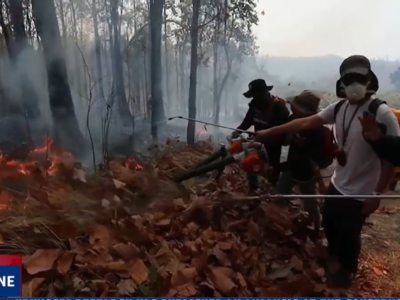Damp and marshy, they seem boring and barren. But contrary to their appearance, tidal flats or coastal wetlands are rich in biodiversity and help maintain balance in the water cycle. For Japan, which hosts 46 of the 2,098 registered wetlands worldwide [pdf], their conservation is essential.
Concern for Japanese precious wetlands is international, with Japan belonging to the Convention on Wetlands of International Importance treaty, better known as “the Ramsar Convention“, which promotes conservation and sustainable use of wetlands.
But community organizations in Japan down on the ground and deep in the mud are the ones who have led the fight in recent years to protect these valuable ecosystems from the encroaching threat of land development and pollution.
A changing landscape

Wajiro Tidal Flat, image from wikimedia commons, photo taken on 2009 (CC BY SA 3.0)
The Save Wajiro Tidal Flat Association [ja], based in Fukuoka city, has fought an uphill battle for more than two decades to preserve the resources of their hometown, the site of the Wajiro Tidal Flat.
The Wajiro Tidal Flat, located in the closed-off section of Hakata Bay, is the largest tidal flat in the Sea of Japan. The flat is also an important stopover and wintering ground for migratory birds.
The landscape of the once tranquil tidal flat in Hakata Bay began to rapidly change around 1994 with the construction of an artificial island. Although Japan's bubble economy was bursting at that time, public officials made development a priority despite doubts over the environmental assessment of the project.
The resulting change in tidal stream has deteriorated the water cycle, with a part of the flat corrupted by algae.
The tidal flat was selected by Japan's Ministry of Environment as a candidate for designation as a Ramsar Wetland of International Importance in 2004, but designation was never made official.

‘Wajiro Tidal Flat at Sunset’ KIRIE-Cutting Paper Art by Hiroko Kusuda. Used with permission.
Hiroko Kusuda, a paper cut-out artist who launched The Save Wajiro Tidal Flat Association in 1988, detailed the practical as well as the poetic significance [ja] of the tidal flat in an article in Radix, the newsletter of Kyushu University:
波静かな和白干潟は,子供たちを水で遊ばせ,人々を恵みの海産物でうるおします。四季を通じて魚貝類,エビやタコ,のり等の食物で人々の命を救い,干潟や浅海域の生物たちの営みで海水を浄化してきました。稚魚や稚貝を育て,和白干潟は生き物だちの命のゆりかごだったのです。
私の命一心も体もこの和白干潟を通して育まれました。自然の美しさや雄大さ,そして厳しさは,感性を豊かにします。和白干潟の自然とのかかわりは,私を創作活動へと導いていきました。大人になった今も,和白干潟は心の安らぎを与えてくれます。
The gentle waves of Wajiro tidal flat let children play in the water, bestow the people with a wealth of wild seafood, fish and shellfish, octopus and shrimp, and seaweed throughout the year. The tidal flat has been here to purify the water by taking care of the creatures of the tidal flat and shallow water and nursing young fish and young shelled sea creatures. The Wajiro Tidal Flat has always been the cradle of life. It has nurtured my mind and body. Beauty, grandeur and rigor of nature provide us an emotional richness. My relationship with the Wajiro Tidal Flat led me to creative activities. Now as an adult, the tidal flat still gives me peace of mind.

‘Spring in Wajiro Tidal Flat’ KIRIE-Cutting Paper Art by Hirorko Kusuda used with permission
Continuing with its efforts, the Save Wajiro Tidal Flat Organization conducts water and sand quality studies every month and organizes popular seashore cleanup events for local residents. Local elementary school students are invited regularly to observe the tidal flat to supplement their lessons.
E.I., who helped oversee the elementary school students, wrote [ja] on the Save Wajiro Tidal Flat Association's blog about how the organization piqued the children's curiosities about the wetland:
今日観察した鳥や、植物、貝殻、海藻の紹介の後、子どもたちから拾った鳥の羽の種類の質問や、アシ原になぜカニの巣穴があるの?などの質問が出されました。拾ったピンクや黄色の小さな貝殻は名前がわからないものもあり、守る会の宿題になりましたが、後で調べたら「ユウシオガイ」というそうです。和白小学校4年生の子どもたちの和白干潟での観察会はこれで終わりですが、2月末には学校で1年間の観察会の発表会があります。私たち守る会も毎年学校に出かけ、発表を楽しみにしています。
After our staff explained about birds, shells and seaweeds that children observed by themselves today, the students asked questions such as the type of bird feathers they found or why crab burrow is in reed bed. Some small yellow and pink shells found by the students couldn't be identified. It became our homework to figure out what they are. On examination, we found out they are Moerella rutila. Today was the last session of Wajiro tidal flat observation for the fourth grade children. But at the end of February there's an annual presentation of the year’s observation by children in school. It is our pleasure to visit school for that every year. We, members of The Save Wajiro Tidal Flat Association, are looking forward to seeing their presentation.
The ebb and flow of conservation work
In 2011, the Ramsar Convention celebrated its 40th anniversary. Reflecting on the years gone by, Japan Wetlands Action Network advisor Satoshi Kobayashi mused [ja] on JAWAN REPORT about how Japan's long-held belief that it could master nature might finally begin to change. The Japan Wetlands Action Network has fought to conserve wetlands on a national and international scale since 1991:
これまで比較的長い間、日本人は高度な技術を制御し、自然を制御しようとしてきた。そしてそれらは制御できるものと思い込んできた。しかしながら、2011年、その思い込みは逆襲される。技術は時に制御できずに悲劇を生むことがあり、自然もまた制御できない側面を持っていることを思い知らされた。
ここで日本人が踏みとどまり、エネルギー政策、国土計画、公共事業の在り方を軌道修正していくことが出来れば、そして世界にモデルを示すことが出来れば、日本人は行動によって世界を変えていくことが出来るのではないか。
For a relatively long time until now, the Japanese have been trying to control nature by using advanced technologies. We have been clinging to the idea that we could do that. But, in 2011, that assumption was smashed. We realized that technology could go out of control and incidentally, could produce a tragedy. Also we realized that nature, too, could go beyond anyone can handle.
If we pause and think, if we shift to make bold initiatives of change for energy policy, national planning and public works, if we demonstrate a role model by doing so, we could change the world by taking such action.
A year later, the organization attended the Ramsar Conference of the Contracting Parties (COP11) in Bucharest, Romania. After participating in the conference, Mr. Kobayashi explained [ja] that now is not the time for conservationists to pat themselves on the back. Progress in tidal flat preservation is a matter of perspective:
会議の運用規則等事務的な手続きが進む中、午前中の最後には条約の科学技術検討委員会(STRP)の議長ヘザー女史からの報告がありました。前回COP10に末娘8歳を連れて参加していたということで、最初にCOP10会議場の前で撮影された娘さんの写真を出しました。おかあさんはどんな業務に関わっているのか知ってもらおうと、会議の最後の方で数時間だけ、末娘に会場後ろの方で聴いていてもらったんだそうです。そして、韓国からの帰りの飛行機で会議はどうだったと尋ねると、「湿地保全の大事さは何となくわかったんだけど、私が大人になったらほとんど湿地が残されていないんじゃないかと心配になっちゃった」と娘さんが言ったんだそうです。「なんだか湿地の保全というのは、あまりにもゆっくりとしか進まさそうな調子だったし…」と続けられて、COP10が実り多い会議だったと思っていたヘザーさんは、言い返すことができなかったんだそうだ。子供恐るべしですね。
While clerical procedures such as operating rules of the meeting progressed, Ms. Heather the Chairman of Scientific and Technical Review Panel (STRP) told us a story at the end of the morning session. She showed us her daughter's photo taken in front of convention hall of COP10. She took her youngest daughter at the age of 8 to the conference to let her know what her mother's doing for work. She asked her daughter to listen in the conference sitting at the back of a room only for a while near the end of the meeting. Then, in the flight back from Korea Ms. Heather asked her daughter what she thought about the conference. The daughter said “I think I got the importance of wetlands conservation but I have worried now that wetlands might not still be here by the time I am an adult.” she continued “Because it seems the conservation of wetlands barely makes any progress…” Ms. Heather said she had not been able to find anything to say back since she had thought the meeting was fruitful.
Children are sharp, aren’t they?
The Japan Wetlands Action Network promotes a nationwide campaign, Wetlands, Tidal Flats Campaign Day [ja], every spring, organizing a variety of events, such as nature observation, discussions, and art exhibitions to help raise public awareness about the conservation of wetland biodiversity. Registration for participating groups is now open [ja].







4 comments
Mangrove Cove: Under the Boardwalk
http://water.thinkaboutit.eu/think5/post/mangrove_cove_under_the_boardwalk
From Th!nk5: Water 2011
Kevin, thank you for sharing the information with nice photos. I’d like to visit there sometime.
children are sharp maybe because they are true nature lovers…
And it is simple love…